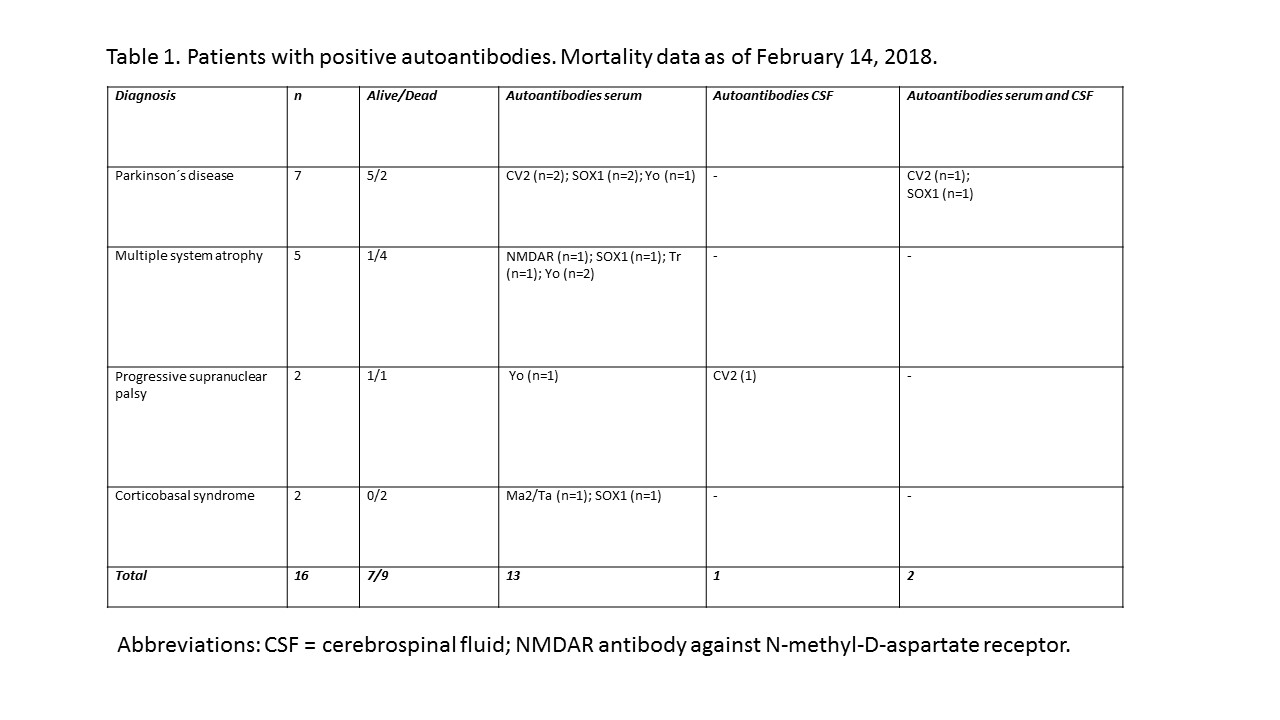Session Information
Date: Monday, October 8, 2018
Session Title: Parkinson's Disease: Neuroimaging And Neurophysiology
Session Time: 1:15pm-2:45pm
Location: Hall 3FG
Objective: To investigate the prevalence of paraneoplastic and antineuronal antibodies in the serum and cerebrospinal fluid (CSF) from patients with Parkinson´s disease (PD) and atypical parkinsonian disorders [multiple system atrophy (MSA), progressive supranuclear palsy (PSP), and corticobasal degeneration (CBD)]. To look for associations between the presence of autoantibodies and clinical parameters including mortality.
Background: Neuroimmunologic mechanisms may be implicated in the pathology of PD and of atypical parkinsonian disorders (1). There are conflicting data in regards to the prevalence of autoantibodies in patients with PD and in healthy individuals (2). There is a lack of data in regard to patients with atypical parkinsonism.
Methods: Paraneoplastic (anti-Hu; Yo; Ri; Ma2/Ta;-CV2/CRMP5; Amphiphysin; SOX1; Zic4; Titin; Recoverin), anti Glutamic Acid Decarboxylase (GAD65), and neuronal surface [anti- N-methyl-D-aspartate receptor (NMDAR); γ-aminobutyric acid receptor B (GABABR); α-amino-3-hydroxy-5-methyl-4- isoxazolepropionic acid receptors 1 and 2 (AMPA1,2); leucine-rich glioma inactivated protein 1 (LGI1); contactin-associated protein 2 (CASPR2); dipeptidyl aminopeptidase like protein 6 (DPPX)] antibodies were analyzed in the serum and CSF from patients with parkinsonian disorders. Onconeural antibodies were analyzed using Euroline lineblot and neuronal surface antibodies were analyzed with indirect immunofluorescence using mosaic slides (Euroimmun, Lubeck, Germany).
Results: 154 patients were investigated (81 males, 73 females). At LP, median (min.-max.) age was 66.5 (26.8 – 87.1) years, disease duration 4.8 (0.9-33.4) years, and Hoehn&Yahr score 3 (1-5). Autoantibodies were identified in 7/67 PD, 5/35 MSA, 2/35 PSP and 2/17 CBD patients (table 1). There was no significant difference between the different diagnoses in regard to autoantibodies. One PD patient (now dead) with anti-CV2 was diagnosed with mammary cancer. One PD patient (alive February 14, 2018) with anti-SOX1 had prostate cancer. In both, antibodies were present in both serum and in CSF. There was no difference between patients with any autoantibodies and those without in respect to gender, age, disease duration, Hoehn & Yahr stage, and occurrence of death as of February 14, 2018. Compared with patients with antibodies, in those without age at death was lower in PD patients (p=0.026) (n=2), and time from LP to death was shorter in atypical parkinsonian patients (p=0.012) (n=7). However, the number of cases was too low for any conclusions to be drawn in regard to these mortality data.
Conclusions: Autoantibodies (SOX1, Yo, CV2, NMDAR, Tr, Ma2/Ta) were identified in about 10% of patients with parkinsonian disorders, mostly in serum but also in CSF. Their presence was not related to clinical parameters, nor to increased mortality.
References: 1. De Virgilio A, Greco A, Fabbrini G, Inghilleri M, Rizzo MI, Gallo A, et al. Parkinson’s disease: Autoimmunity and neuroinflammation. Autoimmun Rev. 2016;15(10):1005-11. 2. Dahm L, Ott C, Steiner J, Stepniak B, Teegen B, Saschenbrecker S, et al. Seroprevalence of autoantibodies against brain antigens in health and disease. Ann Neurol. 2014;76(1):82-94.
To cite this abstract in AMA style:
R. Constantinescu, C. Malmeström, D. Krýsl, D. Jons, M. Axelsson. Paraneoplastic and neuronal surface antibodies in Parkinson’s disease and atypical parkinsonian disorders [abstract]. Mov Disord. 2018; 33 (suppl 2). https://www.mdsabstracts.org/abstract/paraneoplastic-and-neuronal-surface-antibodies-in-parkinsons-disease-and-atypical-parkinsonian-disorders/. Accessed December 14, 2025.« Back to 2018 International Congress
MDS Abstracts - https://www.mdsabstracts.org/abstract/paraneoplastic-and-neuronal-surface-antibodies-in-parkinsons-disease-and-atypical-parkinsonian-disorders/

